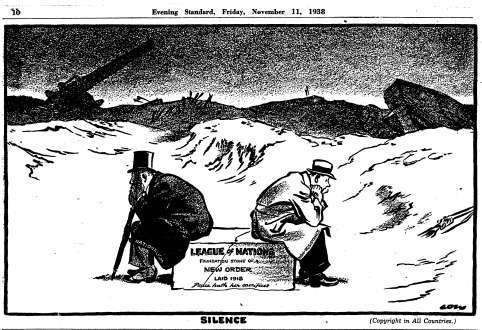Why the League Failed
Source AThis cartoon by the British cartoonist David Low appeared in the Evening Standard newspaper, 11 November 1938. Two figures sit on a cracked stone, which carries the inscription: 'League of Nations. Foundation stone of a New Order, laid 1918. Click here for the interpretation
After the Abyssinian crisis, the League gradually died: 1. The League set up a 'Reform' Committee, to trying to adapt the League to the new political realities of the 1930s. It considered revising the Covenant, being more coercive, being more consultative. It failed. Many countries - including Britain - contracted out of Article 16. 2. Few countries left the League, but all of them realised that it had failed. They stopped relying on the League to protect their sovereignty. Instead they made alliances, re-armed as fast as possible and prepared for war. 3. When war broke out in 1939, the League closed down; its headquarters in Geneva remained empty throughout the war. 4. In 1943 - at a Conference in Tehran - America, Britain and Russia agreed to set up a new international organisation (the 'United Nations') when the war finished. 5. On 12 April 1946, the League met in Geneva and formally abolished itself. The British delegate, Robert Cecil, said: 'The League is dead. Long live the United Nations'.
|
Going DeeperThe following links will help you widen your knowledge: UN debate (1946) on the failure and achievements of the League
Why did the League fail - Sources - essential The League of Nations - views from the web
75 pupil statements on Mr Clare's History Blog - Why did the League fail?.
Consider:1. Look back at the previous pages - especially, analyse the League's weaknesses, and the reasons why it failed in Manchuria and Abyssinia. 2. Make a spidergram of all the ideas you can think of why the League failed. |
Reasons for FailureThe League failed in Manchuria and Abyssinia because it WAS DUMB! Try to explain how each of the following contributed to the failure of the League; click on the yellow pointers to reveal my suggestions.
|
Consider:Think about these reasons the League failed. For each, suggest: a. an example, and b. an explanation, of how that reason might have caused the failure of the League
|
... and a final word:Source BIf the nations want peace, the League gives them the way by which peace can be kept. League or no League, a country which is determined to have a war can always have it. The 1930s historian H.A.L. Fisher sums up the failure of the
League |
Consider:Read HAL Fisher’s ‘last word’ on the League in Source B (he used 35 words). Looking back through this unit, write your own ‘last word’ on the League, taking 35 words. Read your comment to others.
|
|
| |
